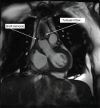Iatrogenic Supravalvular Aortic Stenosis
- PMID: 28516093
- PMCID: PMC5425271
- DOI: 10.12945/j.aorta.2016.16.008
Iatrogenic Supravalvular Aortic Stenosis
Abstract
We describe a case of hemolytic anemia and proximal anastomotic site stenosis following emergency repair of a Type A aortic dissection. This rare complication led to a reoperation to correct the iatrogenic aortic stenosis and cure the consequent hemolysis. A "sandwich" technique (with two Teflon strips on the outside and inside of the aortic wall) was used in the initial repair to reinforce the suture line and prevent bleeding from the aortic anastomoses. At the time of reoperation, the inner Teflon strip at the proximal aortic anastomosis was found to have inverted into the aortic lumen, as suggested by the preoperative magnetic resonance imaging. Surgical treatment consisted of resecting the portion of inner Teflon that had turned in and tacking the remaining part back onto the aortic wall. The observed hemolysis was likely due to the turbulent flow associated with the supra-aortic stenosis and the collision of red cells with the internal Teflon strip. The patient made an uncomplicated recovery with no further hemolysis and was discharged on postoperative day 8.
Keywords: Aortic dissection; Hemolysis; Sandwich technique; Teflon strip.
Figures




Similar articles
-
Aortic stenosis caused by the felt strip used in repair for acute aortic dissection.Interact Cardiovasc Thorac Surg. 2004 Mar;3(1):41-3. doi: 10.1016/S1569-9293(03)00217-2. Interact Cardiovasc Thorac Surg. 2004. PMID: 17670172
-
Hemostatic Proximal Anastomosis for Type A Acute Aortic Dissection: Reversed Turn-Up Technique (Akita Method).Cureus. 2024 Nov 28;16(11):e74647. doi: 10.7759/cureus.74647. eCollection 2024 Nov. Cureus. 2024. PMID: 39734974 Free PMC article.
-
The Utility of Point-of-Care Transesophageal Echocardiography in the Intensive Care Unit for Detecting the Cause of Hemolytic Anemia After Ascending Aorta Replacement.J Cardiothorac Vasc Anesth. 2020 Oct 6:S1053-0770(20)31056-9. doi: 10.1053/j.jvca.2020.09.138. Online ahead of print. J Cardiothorac Vasc Anesth. 2020. PMID: 34756354
-
Long-term integrity of teflon felt-supported suture lines in aortic surgery.Ann Thorac Surg. 2005 Mar;79(3):796-800. doi: 10.1016/j.athoracsur.2004.08.028. Ann Thorac Surg. 2005. PMID: 15734380
-
[End-to-side anastomosis for interrupted aortic arch in neonates and infants].Zhonghua Wai Ke Za Zhi. 2018 Mar 1;56(3):217-220. doi: 10.3760/cma.j.issn.0529-5815.2018.03.010. Zhonghua Wai Ke Za Zhi. 2018. PMID: 29534417 Review. Chinese.
References
Publication types
LinkOut - more resources
Full Text Sources
Other Literature Sources

